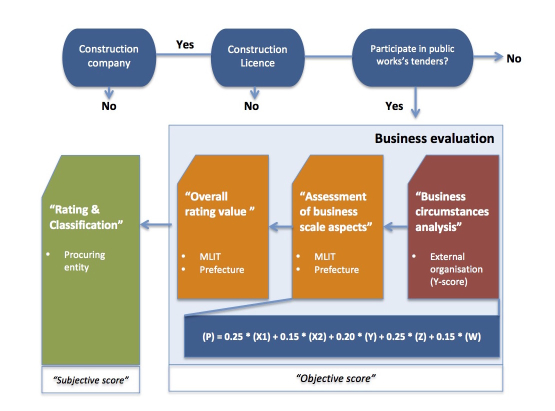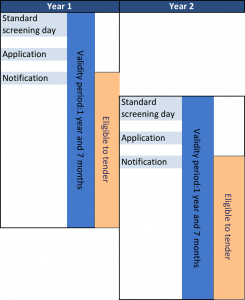
Qualification for public works (Keishin)
In order to be eligible to participate in bidding for government contracts for construction and design of public works an entirely different qualification system exists. This system includes the ‘Business Matters Evaluation’ (keizai jikou shinsa); popularly know as keishin. The system is designed to ensure that Japan government entities are certain that the supplier is able to fulfil the contract it has concluded, which is of particular importance for often-larger scale construction projects.
Prospective bidders will have to apply with each government entity separately, where they wish to participate in the bidding process. As a result, the public works construction market tends see a division where large general contractors are successful in winning large-scale projects spread around the country and smaller construction and design companies win local small batch projects.
The keishin, stipulated by the Construction Business Act (Art 27-23), needs to be taken annually, and it involves a substantial amount of paperwork and also external costs. The keishin itself is actually the first step in obtaining the final supplier qualification, as the results of the keishin (a numerical score) are needed to complete the requirements for the actual supplier qualification.
Schematic overview of Business Evaluation and supplier qualification process

Source: MLIT Kanto Regional Development Bureau (J)
The actual keishin is conducted by a limited number of designated (by MLIT) third-party organisations and companies, who charge a commission starting at EUR 100 to EUR 250 for a three day express service. The standards used in the keishin are nation-wide unified standards.
MLIT designated administrative agencies performing Business evaluations
Company/organisation name | Location | Telephone number | |
Tokyo | +81-3-5565-6131 | N.A. | |
Kumamoto | +81-96-278-8330 | ||
Nagano | +81-26-232-1145 | ||
Nagasaki | +81-95-811-1477
| N.A. | |
Sapporo | +81-11-820-6111 | ||
Utsunomiya | +81-28-649-0111 | ||
Tokyo | +81-3-5753-1588 | ||
Ube | +81-836-38-3781 | ||
Kita-Kyushu | +81-93-474-1561 | ||
Construction Industry Management Information Analysis Center Inc. (CIAC.JP) | Tokyo | +81-545-23-2607 |
Source: MLIT, List as of April 2018 http://www.mlit.go.jp/totikensangyo/const/1_6_bt_000091.html
The designated companies do not offer information on keishin in English. If you wish to obtain the Business Evaluation Notification, the Helpdesk can assist you with the procedures.
Period of validity of the Business Evaluation: “standard screening day”
As business circumstances vary from day to day, the last day before the completed business year (day before settling accounts) is taken as the day on which most of the items in the business evaluation is determined.
The business evaluation is valid for one year and 7 monthsfrom the standard screening day, after receipt of the business evaluation notification. In practice, this means that the business evaluation will have to take place annually.
Schematic overview of business evaluation and qualification process

It is important to keep in mind that when the application for the business evaluation in the following year is done too late, there will be a gap in the eligibility to participate in public works’ tendering.
Source: MLIT Shikoku Office, Business evaluation and Supplier Qualification Guidelines 2014 (In Japanese)
Supplier Qualification Screening
The Supplier Qualification Screening is conducted by MLIT or the government organisation where one is applying for participation in tendering. It will use the score generated from the Keishin (‘Objective Score’) and together with the score of its own evaluation (‘Subjective Score’) a total score is produced. This overall score is then used to rate and classify a company. A list of contact points concerning this screening is available here.
Costs for the Supplier Qualification Screening depend on the number of construction activities a company is applying for and can run up to EUR 600 in case it applies for registration in 14 different categories.
Link: Keishin Guide for Shikoku (In Japanese)
Keishin scoring
What underlies the keishin is a rather complex formula that generates a numerical score (P) for every activity a company wishes to engage in. In this formula, various aspects of a company’s performance are quantified and given a certain weight.
Keishin Business performance calculation | |
(P) = 0.25x (X1) + 0.15x(X2) + 0.20x(Y) + 0.25 x (Z) + 0.15 x (W) | |
X1 | Turnover gained from completed works by type of work |
X2 | Capital and average profit |
Y* | Y expresses the business situation generated from 8 indicators including Ordinary profit ratio, Return on assets, Capital ratio, Business cash flow (absolute) and Accumulated earnings (absolute) Each of these indicators also has its own weight and is put into a formula. |
Z | In-house registered accountants, engineers and specialists, turnover of completed prime contractor work |
W | Other items such as employee welfare, number of years in business, presence/absence of application for corporate rehabilitation, contributions to disaster prevention, law-abidingness, construction accounting situation, R&D, Machinery, ISO |








